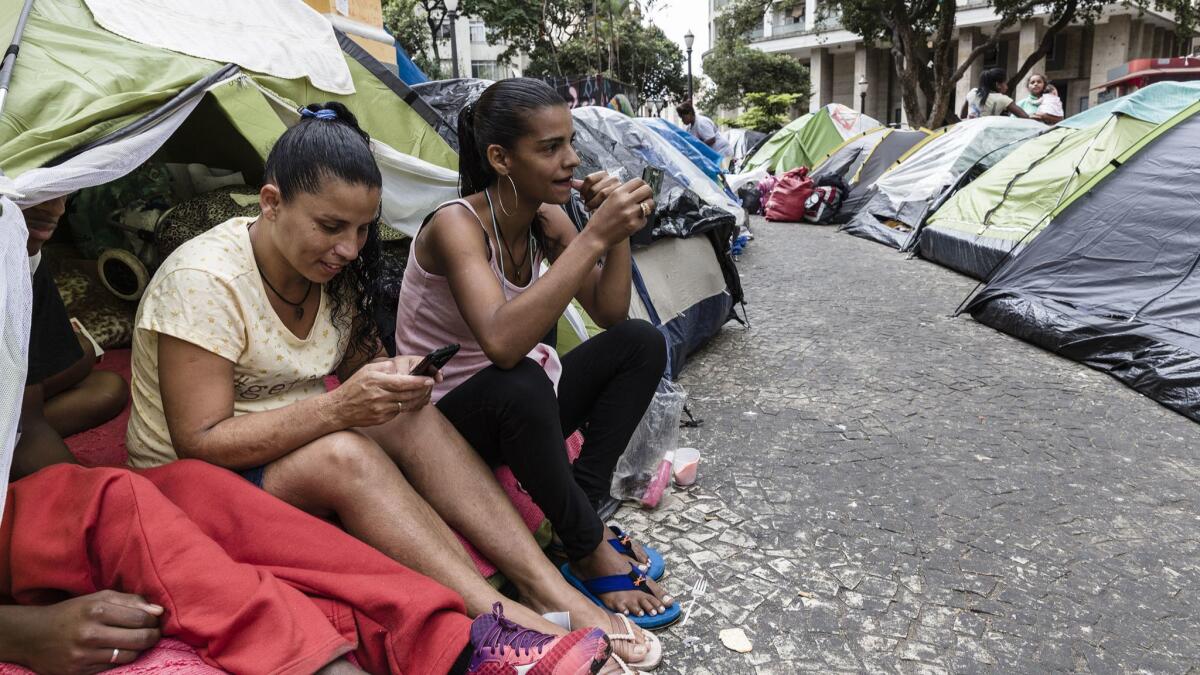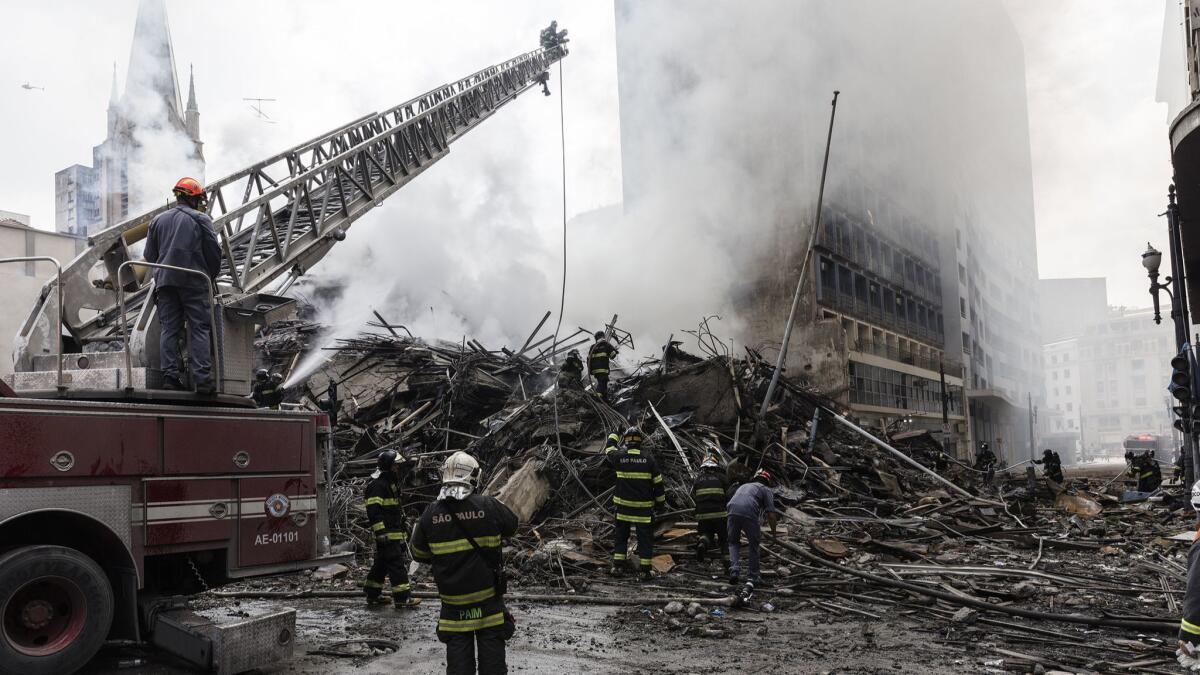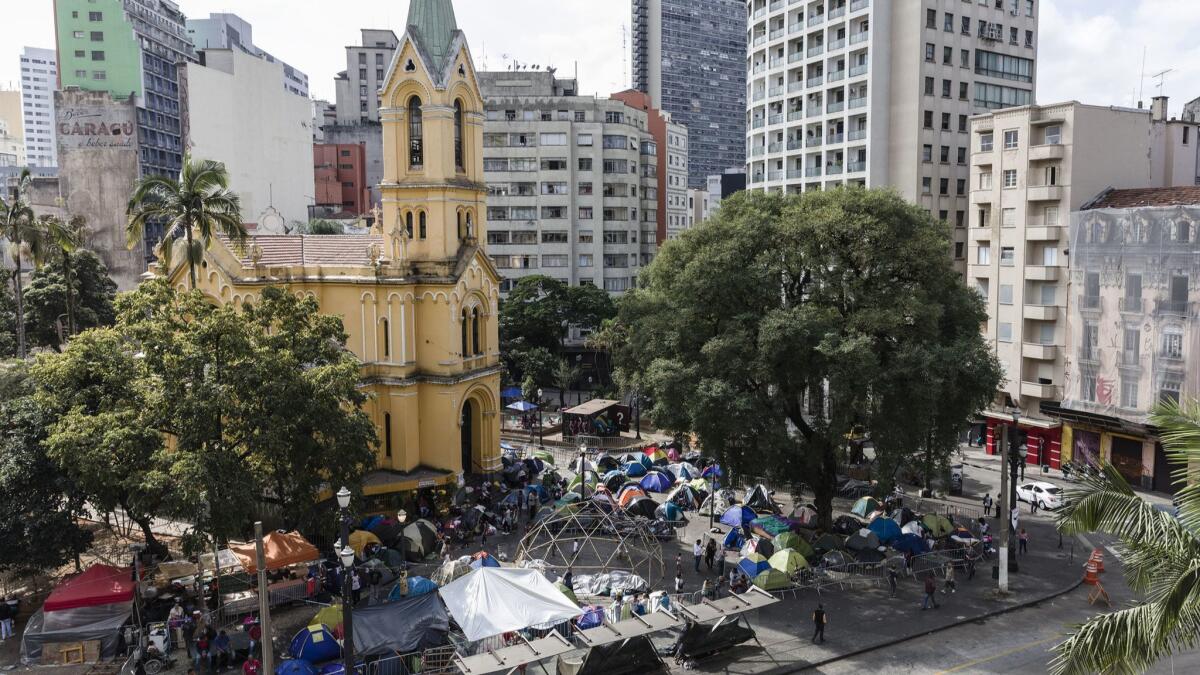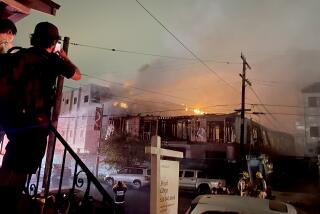They squatted in a government building in Brazil for years. Then they lost everything

Reporting from Sao Paulo, Brazil — Eight years ago, Ana Paula Arcangelo dos Santos and her seven children found a new home.
Known as the Wilton Paes de Almeida, the building had once been the Sao Paulo headquarters of the federal police and home to Brazil’s social security agency. But the police relocated in 2003, and plans to convert the empty building into a cultural center fell through. Squatters like Santos began moving in.
By this May, roughly 400 people were residing there.
The squatters built walls from cardboard and plywood to create their own apartments. Electricity was siphoned off from a traffic light, residents used the stairs because the elevator didn’t work, and the elevator shaft became a catchall for garbage.
Santos, who is 47, and 11 relatives — six of her children, four grandchildren she has been helping raise and a daughter-in-law — all lived in the building.
They paid rent to the Movement for the Social Struggle for Housing, one of many groups here that fight for affordable housing by occupying abandoned buildings across the city.
Santos paid about $60 a month, which was about all she could afford on a monthly salary of $165 cleaning a family’s home five days a week. The minimum wage in Brazil is about $262.
As far back as she can remember, Santos has lived in such “occupations.”
She’s not proud of it, she said, “but I don’t have much of a choice, do I?”
Squatting is illegal, but authorities had long tolerated it, perhaps because housing is so hard to come by in this city of 12 million and it was preferable to having more people living on the streets. The city estimates that people are squatting in about 70 buildings in the downtown area, with untold hundreds of other buildings occupied throughout the rest of the city.
But this year the city’s housing department decided it was time to clear out the Wilton Paes de Almeida. Between February and April the agency held six meetings with the leaders of the housing movement to discuss the risks of living there and the possibility of legal action to remove the squatters.
Then on May 1, the building burned to the ground.
The cause of the fire remains under investigation. But several residents say it started during a brutal fight between a couple on the fifth floor when the man threw alcohol on the woman and lighted a match.

Seven people have been confirmed dead, and two were still missing on May 18, when firefighters concluded their search of what was left of the building. Residents say they’re sure there are more people missing, but many were immigrants or refugees who lived alone and whose family members won’t come looking for them.
Santos, who lived on the sixth floor, escaped after one of her sons, who is training to be a firefighter, told her about the acrid smell he’d noticed when he got home and advised they all leave. She and her relatives could hear the windows pop and shatter from the heat as they ran down the stairs.
The blaze made international news and drew comparisons to a fire last June in London, where 72 public-housing residents were killed at the 24-story Grenfell Tower.
What happened next to Santos’ family and many others from the building has received far less coverage.
Those with nowhere else to go pitched tents next to a bright yellow church nearby. Santos and her relatives, who fill six tents, are among about 180 people living there a month after the fire. They have become a symbol of the massive shortage of affordable housing in Sao Paulo.
The city has offered the families, many with small children, places in its homeless shelters, but most have refused. They say they paid rent and weren’t homeless before the fire and therefore deserve a proper place to live.
The fear is that they would move into shelters and be forgotten.
“There are families that have been waiting for affordable housing for 10 or 15 years,” says Valtair Jose de Souza, known as Carioca, who lived on the first floor and was working the night shift as a parking lot attendant when the building went up in flames.
Now he is one of the organizers of the camp. “Things are moving too slowly,” he said. “We don’t get help quickly enough because of bureaucracy. We can’t wait anymore.”
The camp survives on donations from private citizens, the Red Cross and other organizations.

Among the items Santos claimed: curtains and cutlery, blankets and clothes, a pair of pink roller skates and a blond doll for one of the grandchildren.
“I’m grateful for what people have given me, but what can I do with any of it right now? Where can I put it?” Santos said. “What I need is help with housing. What I need is for the government to see me and all the others here as people who matter.”
Her family and the others rely on a restaurant and shops nearby for running water and bathrooms. Every so often someone from another occupied building in the area visits to ask whether anybody wants to come over for a shower. Santos always welcomes the chance.
The encampment has asked for portable toilets, but the city hasn’t provided them.
The government has also offered $100 toward rent for each family that leaves.
Santos has tried to find an apartment downtown to be close to work and the children’s schools, but a one-bedroom with a kitchenette she looked at was nearly $500 a month — triple her salary.
Her former salary, that is. The family Santos works for put her on leave without pay while she looks for a new place to live.
Langlois is a special correspondent.
More to Read
Sign up for Essential California
The most important California stories and recommendations in your inbox every morning.
You may occasionally receive promotional content from the Los Angeles Times.










